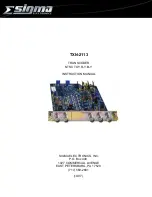
2
DE2294RLU
the upright position. This allows the user to prevent
an accidental “tilt alarm” message from being
transmitted. If a tilt alarm had been transmitted and
the unit was subsequently returned to the upright
position, a “tilt restore” message will be transmitted.
Note:
Please refer to the POM3000 user manual
for further details on this feature.
2.3 Low Battery Voltage Indication
The battery is automatically tested under load
once in 12 hours. If a low battery state is
registered in 3 consecutive tests, a “low battery”
message will be transmitted, and a “low battery”
digital marker will be included in every
transmission, “alarm” or “tilt”. In addition, when the
battery voltage is low, the LED flashes while the
pushbutton is pressed.
2.4 Transmitter Stand
When putting the transmitter away, it is
recommended to use the special stand included in
the package (Fig. 5). The stand will maintain the
unit in a vertical (upright) position, thus preventing
accidental activation of the tilt sensor. Place the
stand on a flat surface, then insert the bottom end
of the unit into the stand.
Figure 4.
Transmitter Stand
2.5 Initial Test
Upon press of the transmission button, the control
panel will sound and display simultaneously
CALLING SERVICE BUREAU… until contact is
established.
This means that the transmitter is
working properly.
Note:
If for any reason the MCT-241 MD RL does
not result in the above response from the control
panel, please contact the central station at 1-800-
894-1428 and verify the PowerCode ID located both
on the unit's package and on the reverse side of the
transmitter
.
2.6 Teaching the Target Receiver
To provide the desired response, the target
receiver must “learn” to identify the Transmitter ID
code. Advise the Central Station (either by
telephone or by fax) of the Transmitter ID located
both on the unit's package and on the reverse side
of the unit.
3
33
3. SPECIFICATIONS
. SPECIFICATIONS
. SPECIFICATIONS
. SPECIFICATIONS
Frequency (MHz):
315, stabilized by SAW resonator
Frequency Tolerance:
±
120 kHz
Modulation:
A.S.K (on-off keying)
Encoding:
Factory programmed, 24-bit digital word
Transmission Duration:
3 seconds (even if the user keeps the
transmission button depressed shorter or longer than that)
Power Supply:
3 V Lithium Battery, 0.7 Ah Panasonic CR-2 only.
(Battery replacement is performed at the factory.)
Current Consumption:
7
µ
A (during standby), 10 mA (during
transmission)
Battery Life Expectancy:
3 years (for typical use)
Battery Condition Indication and Reporting:
A. Good battery
- the LED lights steadily upon transmission.
B. Low battery
- when transmission button is pressed, “low
battery” alarm code is transmitted and the LED flashes.
C. Battery supervision
- every 12 hours. If 3 consecutive “low
battery” states are detected, a “low battery” message is
transmitted.
Operating Temperature:
-10°C to 40°C
(14°F to 104°F)
Dimensions (H x W x D):
With Clip
: 73 x 41 x 30 mm (2-7/8 x 1-5/8 x 1-3/16 in.)
Without Clip
: 67 x 41 x 21 mm (2-5/8 x 1-5/8 x 13/16 in.)
Weight:
35 g (with clip), 30 g (without clip)
Color:
White
Compliance with Standards:
Meets FCC Part 15, MPT1349
and Directive 1999/5/EC
This device complies with the essential requirements and
provisions of Directive 1999/5/EC of the European Parliament
and of the Council of 9 March 1999 on radio and
telecommunications terminal equipment.






















